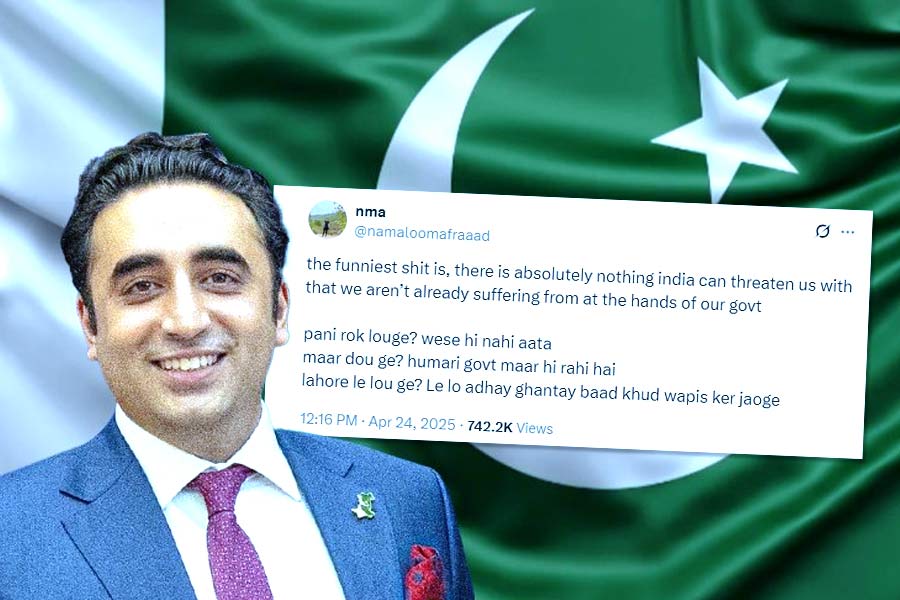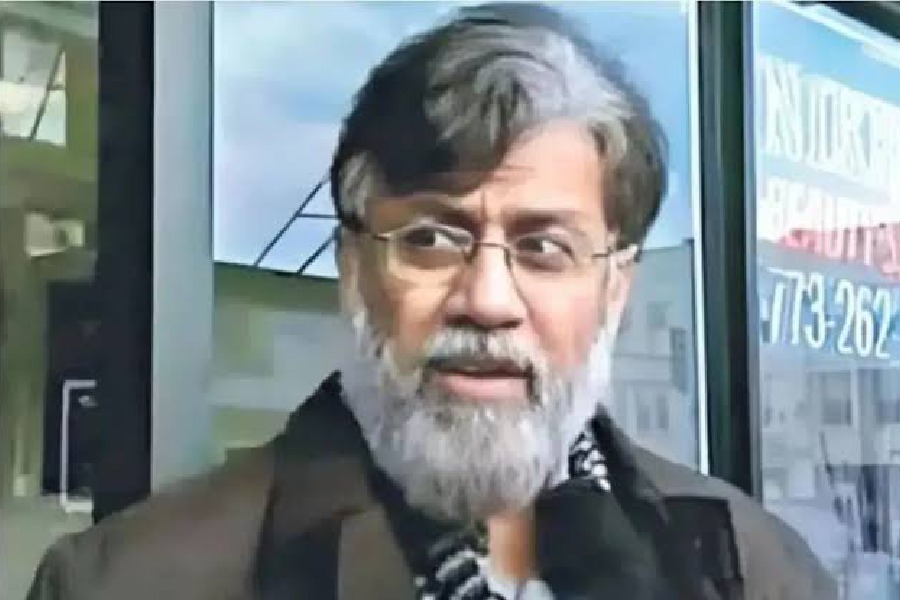|
|
| The Jaipur Gate, 1886 |
An Indian who sets eyes on the exquisitely carved Jaipur Gate overlooking the English Channel at Hove will at once claim it as his own and expect the strains of a shehnai to wail from the domed naqqar khana that crowns the pavilion. Yet, learned British writers dismissed it as “an undigested compilation of all sorts of foreign building styles, Byzantine and Norman” that “represents a largely British idea of India” and could not “be compared to anything that exists in India”.
Such monuments, clustering thickly in this part of Sussex, blend many styles, extant, extinct, and imaginary. The overall mix cannot be associated with any Indian region but is nevertheless instantly recognizable as Indian. That may sound provocative, for art and architecture inspire passionate possessiveness. A Pakistani barrister at Harvard once attacked me ferociously for daring to call the Gandhara school Graeco-Indian. To claim Greek influence on Pakistani art was typical of Indian expansionism, he thundered, then floored me with an astonishing bargain: he would accept all those Buddhas with Greek features as Indian if I conceded that the Taj Mahal was Pakistani.
The current friction between Thailand and Cambodia over the 9th-century Siva temple at Preah Vihear is in a different category. Both countries know that Indians, and not they, created the temple. They just want it as a prized icon. But the Jaipur Gate poses questions about what constitutes India and Indian self-perception since David Beevers, curator of the fine-arts section of the nearby Brighton Museum, suggests in the first of two sensitively perceptive articles that the gate is hardly Indian. The Victorian English saddled India with a fantasy world of art, and coined the phrase, Indo-Saracenic, “to describe combinations of what they took to be Muslim and Hindu motifs”. Beever hints that the motifs may not be Muslim or Hindu at all, except in the imperial imagination. What must be stressed is that few Indians feel any of the revulsion that provoked a purist Aldous Huxley to denounce Indo-Saracenic as all “lavatory bricks and Gothic spires” whose “ugliness is positive, daemonic”. Shaheed Minar is quintessential Calcutta for all its Egyptian base, Syrian column and Turkish dome.
The Indian taste is catholic verging on the flamboyant. Elveden Hall in Suffolk — where Duleep Singh, “Queen Victoria’s Maharajah”, tried to recreate the glittering galaxy of Lahore’s Shish Mahal with thousands of intricately cut and multi-coloured mirrors — is a fine example. True, the solid red-brick mansion was designed by an English architect (like Britain’s other oriental fantasies), but the drawing room expressed an Indian’s concept of the setting in which a high-ranking potentate should receive his guests. None of the other monuments in this genre — led by George IV’s Xanadu by the sea, inspired by a Daniell engraving of Delhi’s Jama Masjid — boasts the same blood connection with India. But I should imagine that as more Indians amass wealth in Britain and hire Versailles and the Victoria Memorial for family nuptials, they will build palaces whose ostentation outdoes Elveden Hall and an East India Company nabob’s even more exotic Sezincote House in Gloucestershire with its onion dome, mock temple and stucco Brahmini bulls.
The Jaipur Gate, a dignified pavilion raised on eight pillars with touches of gilt and the motto “Where Virtue is, is Victory” inscribed in English and Devanagari, was a Maharaja of Jaipur’s gift for the 1886 Colonial and Indian Exhibition. Another exhibition relic, the Durbar Hall, reflecting “a largely European view of a timeless and exotic east”, is now in Hastings Museum. The gate was presented to Hove together with the Gaekwar of Baroda’s pigeon-house, which was a good example of “Bombay wood-carving”, according to the Indian Museum’s T.N. Mukharji. Pictures indicate a quaint “stylistic hybrid” (Beever) topped by what the Art Journal scathingly called “a distorted miniature cenotaph”. It was damaged and dismantled in 1959. An obliging young woman at the Hove Museum, who photocopied all the literature for me free of cost, anxiously explained that the Jaipur Gate might also be in danger. It had to be moved to avoid rainwater collecting on the roof and the wood was affected. It should be indoors, but where’s the room? The delicate pillars stand eight inches above the grass like a woman holding up her sari to avoid the wet and mud.
Hove natives thought the pigeon-house “bizarre” and are indifferent to the Jaipur Gate. Its disappearance would not be missed. Two years ago, a photograph of the Maharaja and Maharani of Jaipur in an exhibition at the Brighton Museum was captioned “an unknown couple” being entertained by a prominent local family. And to think that apart from the gate down the road, Rajmata Gayatri Devi was painted by Annigoni and regarded as one of the world’s ten most beautiful women! Sic transit gloria mundi.
The passing show is more poignant at the Chhatri, a lonely monument on the Downs marking the site where 53 Indian soldiers, victims of World War I, were cremated and their ashes scattered at sea. There was quite a flutter on the bus there when I asked for directions. Several passengers not only knew the Chhatri but also knew that the word means umbrella. One old man said he lost his way trying to go there, another recalled playing by the Chhatri as a child. As I disembarked, a third man said, “Say a prayer for me when you are up there.”
It was an hour’s uphill trudge, the only sign of life on the way a distant herd of Friesian cattle. The Chhatri is not always as neglected. It’s the site of a pilgrimage every June with a local Sikh doing the honours. It belongs to this article because its stark simplicity is also as identifiably Indian as any architectural extravaganza. The small white cupola at the top of a wide flight of granite steps reminds me of those four little pavilions at the corners of one of the Maidan tanks. It could have been anywhere in India.
Art critics might say that a lack of aesthetic sense enables Indians to accept these monuments to Empire. Another explanation could be that since they were devised as “a British view of what India should be” (a brick-and-mortar version of Eric Hobsbawm’s invented tradition), we have as little difficulty in slipping into the niche as our government has in continuing many of the invented rituals. Perhaps we see ourselves as the British did. There may also be a more universal explanation. Jaswant Singh, with his passion for antiquity, should agree with the claim that India is a British invention for he believes India has never had a sense of territory. It has always been a nation, not necessarily a State. There are no pre-colonial maps. But while Lord Curzon did not regard the boundaries that the British parliament drew in 1899 as more than an administrative and revenue-earning convenience that did not contain a nation, Jaswant Singh is emphatic that those boundaries cannot confine the Indian nation. My Pakistani friend might have felt justified in protesting if art and identity are synonymous in India’s borderless world.
Beever’s second and more perceptive article, written after visiting India in 2001, traces the Jaipur Gate to the Panch Mahal at Fatehpur Sikri. Akbar’s capital also inspired the Durbar Hall. Thus, what appears to be an imperial hybrid was the handiwork of the most syncretic of Mughal emperors. Noting Fathepur Sikri’s fusion of “Mughal planning and building types with Hindu stylistic details taken from the Rajput and Gujarati tradition”, Beever cites Thomas Metcalf linking this synthesis to antagonistic communities living contentedly together. There could be no more pithy statement of India’s unity in diversity even amidst Assam’s bloodbath. Or a better explanation of why Indian taste is not narrowly circumscribed.











